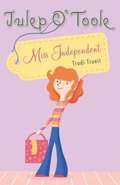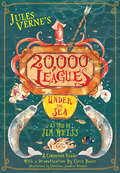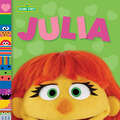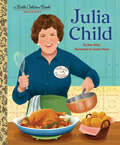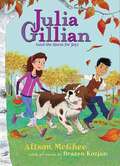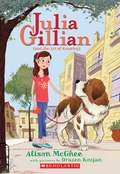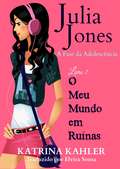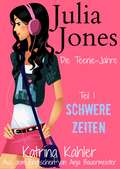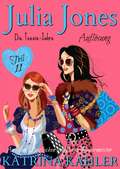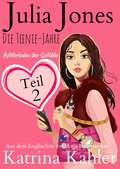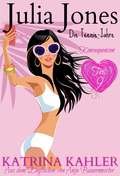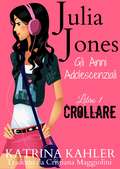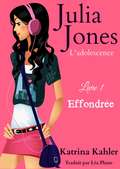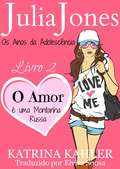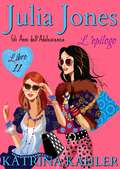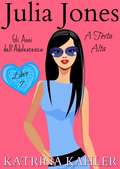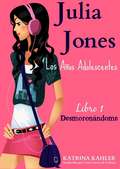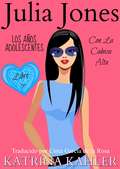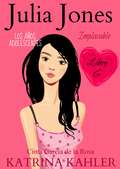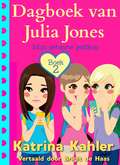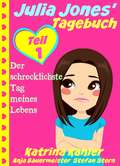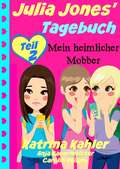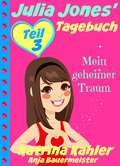- Table View
- List View
Julep O'Toole: Miss Independent
by Trudi TrueitJulep O'Toole feels grown up. She's eleven, after all, and ready to be independent! Now she just has to convince her mom that she's old enough to wear makeup, have a cell phone, choose her own clothes, and make decisions about everything else in her life. After all, her mom lets Julep's older sister, Harmony, do all these things. but just when Julep thinks her mom is finally starting to listen to her, a disastrous shopping trip stops everything. Now Julep and her mom are not even speaking! Will Julep ever be understood and finally have the chance to be herself?
Jules Verne's 20,000 Leagues Under the Sea: A Companion Reader with a Dramatization
by Jim Weiss Chris Bauer Christiana SandovalLost at sea, three friends find themselves on a fantastic underwater ship, the Nautilus. You will dive deep into adventure as our heroes battle giant squid, navigate dangerous oceans, and discover new creatures and fabulous treasures. But who is the mysterious Captain Nemo? Why is he being hunted by every navy on earth? And will he ever let the three castaways return home? This beautifully illustrated Companion Reader is an exact transcript and dramatization of Jim Weiss’s award-winning storytelling performance of Jules Verne’s Twenty Thousand Leagues Under the Sea, available on MP3 and audio CD from Well-Trained Mind Press. For decades, Jim Weiss has entertained his many listeners with gripping plots, vivid characters, and beautiful words. But his performances are much more than mere entertainment. Jim's stories build language skills by filling young minds with wonderful vocabulary, complex sentence structures, and rich images. Now, our Companion Readers bring these language-learning benefits to a new level. Language, both written and oral, is most easily and thoroughly learned when heard, read, and spoken. Listen to the Jim Weiss performance on CD or MP3. Read along with the performance. The first half of this book as word-for-word transcript of Jim Weiss's performance. Students can improve their reading fluency, vocabulary, and their understanding of punctuation, sentence structure, and grammar by following along as Jim performs these words. Even students who are not at the level represented in this book can be moved forward in reading competency by reading along as Jim speaks the words. Say the words. The final element in language learning is to speak great words and sentences out loud. Jim's retelling of Jules Verne's classic tale has been turned into a short, accessible dramatic version that can be performed by two or more actors. The play can be memorized or read from the scripts; either way, students will begin to gain confidence in their own language use and in their ability to speak in front of others.
Julia (Sesame Street Friends)
by Andrea Posner-SanchezMeet your favorite Sesame Street friends in this adorable photographic board book starring Julia, a muppet with autism!Elmo's friend Julia is the star of this colorful, photographic board book. Babies and toddlers will love turning the sturdy pages to find out what Julia--a muppet with autism--likes to do with her family, her puppy, and her Sesame Street friends. Look for all the Sesame Street Friends books:ELMO ABBY BIG BIRD COOKIE GROVER OSCARTHE COUNT BERT & ERNIESesame Workshop, the nonprofit educational organization behind Sesame Street, aims to help kids grow smarter, stronger, and kinder through its many unique domestic and international initiatives. These projects cover a wide array of topics for families around the world.
Julia Child: A Little Golden Book Biography (Little Golden Book)
by Kari AllenDream big with a Little Golden Book biography about Julia Child, the chef and cookbook author who introduced Americans to the art of French cooking. It's the perfect introduction to nonfiction for young readers—as well as fans of all ages!This Little Golden Book about Julia Child—beloved for her entertaining and informative cooking shows—is an inspiring read-aloud for all young sous chefs. Bon appétit!Look for more Little Golden Book biographies: • Harry Belafonte • Martha Stewart • Iris Apfel • Oprah Winfrey • Jacques Pépin
Julia Gillian (Julia Gillian)
by Alison Mcghee Drazen KozjanSo far, fifth grade at Lake Harriet Elementary School is not exactly a thing of joy. Julia Gillian's best friend, Bonwit Keller, is keeping a secret from her. Trumpet lessons with Mr. Mixler, her favorite teacher, are much harder than expected. And most upsetting of all, the kind lunch lady has been replaced by a tyrant known as the Dumpling Man. Where is the joy? Amidst all this, Julia Gillian starts keeping secrets of her own--secrets that feel an awful lot like lies. To set things right, she will have to learn a little bit about friendship and honesty.
Julia Gillian and the Art of Knowing (Julia Gillian)
by Alison Mcghee Drazen KozjanTen-year-old Julia Gillian knows everything about her quirky neighbors, her Minneapolis neighborhood, even the inscrutable "claw machine" in the back of the corner hardware store. The one thing Julia Gillian doesn't know is how the book she's reading is going to end. It doesn't seem as if it's going to have a happy ending, and that scares her. But Julia learns a little something about fear: sometimes you just have to work through it. And though bad things do happen sometimes, having good friends and family around you makes life a bit less scary - and much more fun.
Julia Jones - A Fase da Adolescência - Livro 1 - O Meu Mundo em Ruínas
by Katrina Kahler Elvira Sousa"Olhei, com horror, para o que estava diante dos meus olhos. A semelhança era impressionante. Tinha o mesmo cabelo, comprido e castanho, e os mesmos olhos cor de avelã, iguais aos meus; mas, o sorriso era tenebroso. Completamente paralisada com o choque, fiquei ali, de pé, com a cabeça a fervilhar de confusão e pânico. Tive de recorrer a todas as minhas forças para não soltar os gritos de medo que se formaram dentro de mim. Com a boca aberta de espanto, não conseguia desviar os olhos daquela figura horrível que tinha sido lançada para o fundo do meu cacifo..." Assim começa o enredo de "Julia Jones- A Fase da Adolescência". Este Livro 1, "O Meu Mundo em Ruínas", é a continuação da famosa série "O Diário de Julia Jones" e de todas as suas peripécias, agora, ainda mais excitantes e arrebatadoras. Julia é uma adolescente típica. Contudo, a sua vida vai mudar, de forma repentina e dramática, quando a família é obrigada a regressar à velha cidade onde moravam. Vivendo momentos de grande agitação e de caos, Julia procura lidar com a situação recorrendo à sua amiga Millie Spencer e ao amor da sua vida, Blake Jansen. Mas, quando chega à sua antiga casa, depressa se apercebe que muita coisa tinha mudado durante o tempo que estivera ausente. Os dias que se vão seguir trazem-lhe essa confirmação e Julia vai ter de enfrentar uma espiral estonteante de novas situações dramáticas. Embora ela tente assumir o controlo, a sua vida parece encaminhar-se para o desastre total que Julia parece incapaz de impedir. Julia pensa que as suas escolhas em relação ao amor, a amigos, a festas e a comportamento acabam sempre por lhe trazer dissabores e as piores consequências. Qual a razão de tanta infelicidade? Como lidar com tantos desafios? O enredo deste livro está repleto de suspense e de acontecimentos imprevistos que vão cativar os leitores desde o início. Se gostou da série "Julia Jones", ou se é um novo l
Julia Jones - A Fase da Adolescência - Livro 3 - Amor Verdadeiro
by Katrina Kahler Elvira SousaA saga de Julia Jones - Os Anos da Adolescência - continua a desenrolar-se neste livro fabuloso. Romance, suspense e drama são os ingredientes que vão cativar os leitores desde a primeira página. Afinal, qual é a grande paixão da Julia? Será o Blake ou o Ky? Ou será que outra pessoa lhe vai roubar o coração? O que vai acontecer com a Sara ? Continuará a infernizar a vida da Julia? Os leitores vão encontrar as respostas para estas questões (e para muitas outras!) neste terceiro livro da série, o mais romântico e intenso de todos. Um livro maravilhoso para jovens, que, certamente, terão muito prazer na sua leitura!
Julia Jones - Die Teenie-Jahre - Teil 1: Schwere Zeiten
by Katrina Kahler Anja BauermeisterTeil 1 von „Julia Jones – Die Teenie-Jahre“ führt die beliebte Kinderbuchreihe von „Julia Jones’ Tagebuch“ für ältere Mädchen fort. Julia ist jetzt ein typischer Teenager, deren Leben vollkommen unerwartet auf den Kopf gestellt wird, als ihre Familie zurück in ihr altes Haus in der Stadt zieht. Sie versucht, das Beste daraus zu machen, und setzt sich mit ihren alten Freunden in Verbindung: Millie Spencer und Blake Jansen, der Liebe ihres Lebens. Doch kurz nach ihrer Ankunft muss sie feststellen, dass sich während der letzten drei Jahre alles dramatisch verändert hat. Und egal, wie sehr sie sich auch bemüht, sie kann es nicht verhindern, dass sich ihr Leben unaufhaltsam in einen schlimmen Albtraum zu verwandeln scheint. Was ist die Ursache für Julias Probleme und wie wird sie mit diesen neuen Herausforderungen umgehen? Nicht nur Fans der Julia-Jones-Reihe, sondern auch neue Leserinnen werden dieses spannende Buch lieben. Mädchen ab 12 Jahren werden sich in den Problemen von Julia wiedererkennen.
Julia Jones - Die Teenie-Jahre Teil 11: Auflösung (Julia Jones - Die Teenie-Jahre #11)
by Katrina Kahler„Julia Jones – Die Teenie-Jahre Teil 11: Auflösung“ beendet die Saga von Julia Jones, eine Reise, die von ihrer Kindheit bis in ihre Jugendzeit führt. Endlich erfahrt ihr, warum Davian hinter Emmie und Chloe her ist. Können die beiden Mädchen ihn überlisten, bevor er seinen Plan in die Tat umsetzt? Wie geht es mit Julias Bruder Matt und seiner Freundin Lisa weiter? Und wird die Dreiecksbeziehung zwischen Julia, Ky und Blake jemals aufgelöst werden? Mit der gewohnten Portion Drama, Romantik und Spannung kommen Fans der Julia-Jones-Reihe auch hier wieder voll auf ihre Kosten.
Julia Jones - Die Teenie-Jahre Teil 2 - Achterbahn der Gefühle
by Katrina Kahler Anja BauermeisterDer zweite Teil von „Julia Jones – Die Teenie-Jahre“ vermag es erneut, junge Leserinnen zu fesseln. Diesmal steht Julia eine wahre Achterbahn der Gefühle bevor. Nicht nur, dass sie sich mit ihrer alten Rivalin Sara herumschlagen muss, auch ihr Ex-Freund Blake scheint ziemlich schnell über sie hinwegzukommen. Wird Julia neue Liebe finden oder sich die falschen Freunde suchen? Eine verhängnisvolle Party sowie eine folgenschwere Entscheidung ihrer Mutter treiben Julia an den Rand des Abgrunds. Wird sie es schaffen, stark zu bleiben, und auch diese Krisen überstehen? Können Julia und Blake ihre Beziehung kitten? Mädchen ab 12 werden sich in Julias Problemen und Sorgen wiederfinden und das Buch nicht aus der Hand legen können.
Julia Jones - Die Teenie-Jahre Teil 3 - Wahre Liebe
by Katrina Kahler Anja BauermeisterRomantik, Spannung und Drama erwarten euch auch im dritten Teil von „Julia Jones – Die Teenie-Jahre“. Julia ist hin- und hergerissen zwischen ihrer Eifersucht auf Blakes neue Freundin und ihrem neuen Schwarm, dem mysteriösen Ky. Doch sie ist nicht sicher, was er für sie empfindet. Und warum fehlt er so oft in der Schule? Ihre Gedanken drehen sich im Kreis, bis ihr Bruder vorschlägt, eine Halloweenparty bei ihnen zu Hause zu veranstalten – für Julia eine willkommene Ablenkung. Allerdings läuft dabei nicht alles so wie geplant. Wird die Party in einer Katastrophe enden? Und wer ist Julias wahre Liebe? Findet es heraus in „Teil 3 – Wahre Liebe“. Ein fesselndes Buch für Mädchen ab 12.
Julia Jones - Die Teenie-Jahre Teil 9: Konsequenzen (Julia Jones - Die Teenie-Jahre #9)
by Katrina KahlerJulia ist noch immer hin- und hergerissen zwischen den beiden besonderen Jungen in ihrem Leben, aber jetzt hat sie wenigstens Emmies Unterstützung. Und als Emmie beschließt, Julia ihr Geheimnis zu verraten, erkennt Julia, dass ihre beste Freundin noch viel größere Probleme hat, als sich zwischen zwei Jungs entscheiden zu müssen. Wer ist diese Chloe und was hat es mit Davian auf sich? Schwebt Emmie gar in Gefahr? Als die beiden Mädchen eine unerwartete Gelegenheit wahrnehmen, es Julias Erzrivalin Sara heimzuzahlen, geraten die Dinge schnell außer Kontrolle und Julia und Emmie müssen sich den Konsequenzen ihrer Handlungen stellen. Julia Jones – Die Teenie-Jahre Teil 9 ist ein spannendes Buch für junge Mädchen von 11-15, das die beliebte Julia-Jones-Serie fortsetzt. In diesem Teil werden die Ereignisse neben Julias Perspektive auch aus Emmie Walters’ Blickwinkel erzählt.
Julia Jones - Gli Anni Adolescenziali - Libro 1 - Crollare
by Katrina Kahler Cristiana MaggioliniIl Libro Uno, “Crollare” è il proseguo della serie di best seller ricco di suspense “Il diario di Julia Jones” ma è ancora più avvincente ed eccitante dei precedenti. Julia è una tipica teenager catapultata all'improvviso ed in modo inaspettato nel caos a causa del trasloco forzato della sua famiglia alla loro vecchia casa in città. Ella cerca di venire a patti con il suo dilemma riallacciando i rapporti con la sua vecchia amica, Millie Spencer e anche con l’amore della sua vita, Blake Jansen. Tuttavia, all'arrivo alla sua vecchia casa, apprende subito che le cose sono cambiate radicalmente mentre lei era via. I giorni che seguono sembrano sbrogliarsi in una serie infinita e crescente di drammi ed avvenimenti. Sebbene Julia cerchi di mantenere il controllo, la sua vita sembra impennarsi verso un terribile disastro che lei non appare in grado di impedire. Julia trova che le sue scelte che riguardano la sfera dell’amore, delle amicizie, feste scatenate e comportamento ribelle tipico dei teenager finiscono sempre per avere un esito negativo. Qual è la causa del triste stato di Julia e come affronta lei le sfide che la vita le pone davanti? Questo racconto è intriso di colpi di scena e svolte impreviste che vi terranno inchiodati alla sedia desiderosi di scoprire cosa succederà in seguito. Per le fan irriducibili di Julia Jones e anche per coloro che vengono per la prima volta a contatto con questa eroina, questo libro non vi deluderà. Non perdetevi il viaggio ricco di suspense, pieno di storie d’amore, drammi, storie di amicizie e molto, molto ancora. Questo libro favoloso adatto alle ragazze adolescenti contiene al suo interno tutti gli elementi per dare vita ad una storia eccitante che le ragazze di tutte l’età ameranno.
Julia Jones - L’adolescence Livre 1 Effondrée
by Katrina Kahler Léa PlasseJulia est devenue une adolescente comme les autres, mais connaît de grands chamboulements dans sa nouvelle vie, à cause de la mutation forcée de son père dans leur ancienne ville et le retour dans leur ancienne maison. Elle essaye de trouver du réconfort dans cette nouvelle situation en reconnectant avec son ancienne meilleure amie, Millie Spencer, et aussi avec l'amour de sa vie, Blake Jensen. Mais pourtant, en arrivant dans son ancienne vie, elle réalise que les circonstances ont énormément changé pendant son absence, et les jours qui suivent son arrivée vont être mouvementés. Elle essaiera de garder le contrôle, mais une suite d'évènements dramatiques la rendra impuissante devant cet engrenage désastreux. Julia va réaliser que ses choix concernant sa vie, ses amis, ses amours, des soirées trop arrosées et un comportement d'ado rebelle auront des conséquences directes et terribles sur sa situation. Pourquoi est-elle aussi malheureuse, et comment gérer les obstacles sur son chemin ? Ce livre, plein de rebondissements inattendus, vous plongera dans un suspense intense, et vous ne pourrez pas le lâcher avant de savoir la suite. Pour les fans de Julia Jones depuis ses débuts ou pour les nouveaux adeptes, ce livre ne vous décevra pas. Ne manquez pas les nouvelles aventures de Julia Jones, pleines d'amour, de drames, d'amitié et bien plus encore. Ce fabuleux livre pour adolescentes contient tous les éléments possibles pour séduire les filles de tous les âges.
Julia Jones - Os Anos da Adolescência - Livro 2: O Amor é uma Montanha Russa
by Katrina Kahler Elvira Sousa"O Amor é uma Montanha Russa" continua a saga de Julia Jones durante o período da adolescência. Este livro é o MAIS excitante e dramático da série. Os fãs da Julia Jones vão seguir as suas últimas aventuras, com entusiasmo e suspense. Num enredo cheio de agitação e caos, Julia é obrigada a enfrentar uma série de acontecimentos, completamente inesperados, que lhe vão proporcionar uma nova experiência - uma viagem de montanha russa, repleta de romance e drama, na qual deverá manter-se forte para sobreviver. Mas, será Julia capaz de lidar com o bullying impiedoso da Sara? Será que ela consegue reatar a sua relação com Blake? Será que vai encontrar a felicidade e o amor que tanto procura? Descubra as respostas a estas perguntas, lendo "Julia Jones - Os Anos da Adolescência - Livro 2: O Amor é uma Montanha Russa." Não se vai arrepender!
Julia Jones – Gli Anni dell’Adolescenza: Libro 11 – L’Epilogo (Julia Jones Gli Anni dell’Adolescenza #11)
by Katrina KahlerJulia Jones – Gli Anni dell’Adolescenza: Libro 11 – L’Epilogo Questo libro conclude la serie di Julia Jones, che segue le vicende di Julia dagli anni in cui frequenta la scuola media e nella transizione all’adolescenza. In quest’ultimo libro, il mistero di Davian viene finalmente svelato. Riusciranno Emmie e Chloe a superarlo in astuzia o sarà Davian ad aver la meglio? Cosa c'è in serbo per il fratello di Julia, Matt, e la sua ragazza, Lisa? E come affrontano i giovani adolescenti la tragedia che si imbatte sulle loro vite? E per finire, il triangolo amoroso che include Julia, Ky e Blake verrà mai risolto? Dovrai leggere il libro fino alla fine per trovare risposta a queste domande. Dramma, romanticismo e suspense si combinano per creare un'altra storia emozionante. L’Epilogo è un libro che tutti i fan di Julia Jones apprezzeranno sicuramente.
Julia Jones – Gli Anni dell’Adolescenza: Libro 7- A Testa Alta
by Katrina KahlerJulia Jones Gli Anni dell’Adolescenza - Libro 7... Quando il cyberbullismo giunge ad un livello senza precedenti, Julia decide è ora di farsi valere. Ma riuscirà a fermare Sara una volta per tutte? O la sete di vendetta di Sara sarà troppo intensa? E cosa succederà quando Ky inizierà a mostrare un improvviso interesse per Julia? In questa aggiunta alla serie troverete un libro ricco di drammi, colpi di scena, e ancor più romanticismo. Vi coinvolgerà dall’inizio alla fine, sorprendendovi con una conclusione romantica. Una montagna russa d’emozioni.
Julia Jones – Los Años Adolescentes – Libro 1: Desmoronándome (Julia Jones – Los Años Adolescentes #1)
by Katrina Kahler Cinta"Miré con horror lo que me devolvía la mirada. El parecido era sorprendente. Tenía el mismo pelo castaño largo y ojos marrones como los míos, pero la mueca morbosa era horrible. Paralizada de asombro, me quedé allí, mi mente girando en confusión y pánico. Tuve que utilizar cada última reserva de autocontrol para contener los gritos asustados que sentía me bullían en mi interior. Con la boca abierta, no podía retirar la mirada de la fea figura que había sido metida en el fondo de mi taquilla." Este fragmento comienza la historia de "Julia Jones – Los Años de Adolescencia". El Libro 1, "Desmoronándome" continúa la serie de suspense y líder en ventas "El Diario de Julia Jones", pero es aún más excitante y emocionante que nunca. Julia es ahora una típica chica adolescente, pero se ha visto envuelta en un torbellino brusca e inesperadamente por la forzada reubicación de su familia de vuelta a su antigua casa en la ciudad. ella intenta reconciliarse con el dilema de volver a conectar con su antigua amiga, Millie Spencer, y también con el amor de su vida, Blake Jansen. Sin embargo, al llegar a su antigua casa pronto aprende que las circunstancias han cambiado dramáticamente durante el tiempo que ha estado fuera, y los días que se suceden parecen desencadenar en una serie de drama creciente. Aunque Julia intenta mantener el control, su vida parece una bola de nieve que va hacia un desastre que lo consume todo, y ella parece no tener el poder de prevenirlo. Julia descubre que sus elecciones en torno al amor, los amigos, las fiestas salvajes, y el comportamiento rebelde adolescente tiende a resultar en consecuencias directas y repercusiones del peor tipo. ¿Cuál es la causa de las miserias de Julia y cómo trata los desafíos en el camino? Éste es un libro lleno de giros inesperados que te mantendrá en el borde de la silla preguntándote qué va a pasar a continuación. Para las fans incondicionales de Julia Jones,
Julia Jones – Los Años Adolescentes – Libro 7: Con la Cabeza Alta (Julia Jones – Los Años Adolescentes #7)
by Katrina KahlerComo el ciberacoso aumenta hasta llegar a límites insospechados, Julia decide que ya es hora de plantarles cara. Pero, ¿podrá detener a Sara de una vez por todas, o la venganza de Sara es demasiado profunda? ¿Y qué pasa cuando Ky empieza a mostrar un repentino interés por Julia? Más drama, más suspense, y más romance es lo que puedes esperar en esta nueva entrega de la serie. Te cautivará desde el comienzo hasta su romántica y emocional conclusión.
Julia Jones – Los Años Adolescentes: Implacable (Julia Jones – Los Años Adolescentes #6)
by Katrina KahlerJulia Jones – Los Años Adolescentes: Libro 6 Esta historia está más llena aún de drama y suspense mientras Julia intenta lidiar con los retos que se le presentan en su camino. No solo fue traicionada por su mejor amiga, Millie, sino que su oportunidad de reiniciar su relación con Blake parece condenada al fracaso. Por suerte, tiene la distracción de una nueva prueba de trabajo así como la oportunidad de pasar la noche en casa de Emmie, y eso es algo que espera con impaciencia. Sin embargo, un inesperado enfrentamiento lleva a más agitación y desesperación cuando Julia descubre que está siendo objeto de una nueva forma de acoso. ¿Quién será responsable y por qué? Este fabuloso libro para adolescentes te mantendrá sentada en el borde de tu asiento, tratando de averiguar el final. Es una gran historia que todos los fans de la serie de Julia Jones disfrutarán seguro.
Julia Jones' Dagboek Boek 2 Mijn geheime pestkop (Julia Jones' Dagboek #2)
by Katrina KahlerToewijding Dit boek is opgedragen aan alle lieve meiden die zelf ook om moeten gaan met pestkoppen! Ben zelfverzekerd, en sta sterk...niemand is beter dan jij!
Julia Jones' Tagebuch - Teil 1 - Der schrecklichste Tag meines Lebens
by Katrina Kahler Anja BauermeisterJulia freut sich schon riesig auf das aufregendste Ereignis des ganzen Schuljahres - das Schul-Musical. Der süßeste Junge der Schule tritt ihrer Tanztruppe bei und Julia kann es kaum erwarten, bis die große Show endlich stattfindet. Doch dann kommt eine neue Schülerin, Sara Hamilton, in ihre Klasse und Julias Welt wird auf den Kopf gestellt. Sara ist eine extrem gute Tänzerin und wird rasch zum beliebtesten Mädchen der Schule. Nur für Julia scheint sie irgendwie nichts übrig zu haben, oder bildet Julia sich alles nur ein? Als schließlich der langersehnte Tag anbricht, überschlagen sich die Ereignisse. Was der Höhepunkt des Jahres hatte werden sollen, endet in einer Katastrophe. Wird Julia sich von dem schrecklichsten Tag ihres Lebens wieder erholen? Dieser erste Teil in der Julia Jones Reihe ist kurzweilig geschrieben und wird junge Leserinnen von der ersten Seite an mitreißen. Das Buch eignet sich sehr gut für Mädchen zwischen 9 und 12 Jahren.
Julia Jones' Tagebuch - Teil 2 - Mein heimlicher Mobber
by Katrina Kahler Anja BauermeisterJulia ist eine ganz normale 12-Jährige, die es liebt, zu tanzen und mit ihren Freunden in der Schule Zeit zu verbringen - das heißt, bis Sara Hamilton in ihre Klasse kommt und sich alles verändert. Nie zuvor hatte sie es mit einem Mädchen zu tun, das so gemein ist und sie bei jeder Gelegenheit heruntermacht und demütigt. Julia hat das Gefühl, sich an niemanden wenden zu können und schlägt sich ganz allein mit Sara herum. Kann sie es schaffen, sich gegen Sara aufzulehnen? Oder wird Sara am Ende triumphieren? Diese Geschichte ist aus dem echten Leben gegriffen. Sie zeigt jungen Mädchen, wie man sich gegen Mobber verteidigen und lernen kann, zu sich selbst zu stehen. Ein weiteres Tagebuch, das junge Leserinnen mitreißen und inspirieren wird.
Julia Jones' Tagebuch - Teil 3 - Mein geheimer Traum
by Katrina Kahler Anja BauermeisterJulia wird von Zweifeln geplagt: Wird sie jemals so viel Glück haben wie ihre beste Freundin, der eine tolle Sache nach der anderen nur so in den Schoß zu fallen scheint? Darunter auch die Gelegenheit, mit dem neuen süßen Typen der Schule abzuhängen, an den Julia ständig denken muss? Alles scheint schiefzulaufen - bis sie ein ganz besonderes Buch entdeckt. Es hilft ihr dabei zu glauben, dass sie ihre geheimen Träume vielleicht doch wahr werden lassen kann. Was ist Julias geheimer Traum? Diese Geschichte wird junge Leserinnen inspirieren und mitreißen.
